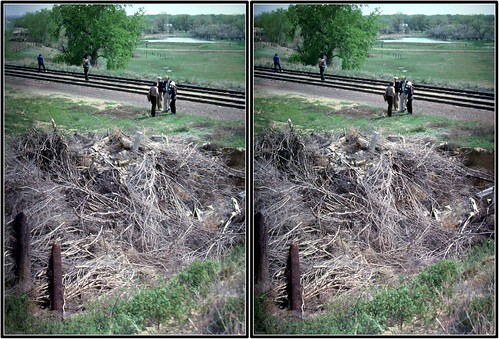A Time Team episode will tonight investigate one of the most controversial debates in American archaeology: when, and by what route, did the first humans arrive in America? University of South Carolina archaeologist Al Goodyear claims to have found evidence at the archaeological site of Topper in South Carolina that could change our whole understanding about America’s earliest people.
The Topper site is one of a handful of what are thought to be Clovis sites discovered since the 1920s in the Americas, including the more famous Mesa Verde and Monte Verde, and the less prettily-named Head-Smashed-In. The Clovis era, around 12500-12900 BC, was generally agreed to represent the earliest human inhabitation of the Americas. Clovis society revolved around big game hunting, and man was capable of creating distinctive tools for hunting and butchering. He was also capable of the kind of unsustainable hunting technique that would make conservationists turn in their graves.
If the hunting to extinction of endangered species by man makes your blood boil, look away now.
One Clovis hunting technique the Buffalo Jump – involved surrounding a large herd of Buffalo or bison (or any other suitably at-risk animals), and charging at them until they were effectively herded over the edge of a cliff. At the bottom of the cliff, they would pick one or two animals to butcher and eat, and leave the rest to rot. There would be a lot of waste.
It is thought that over-hunting, combined with a loss of fauna through climate change, led to the decline of big game populations. And with no big game to hunt, the big game hunters were wiped out. A ‘black mat‘ discovered in America from the same era suggests an alternative ending to the Clovis people. It is thought that the blackened area is the result of a meteorite hitting the earth, which would have sparked widespread fires across the dry plains of America, wiping out the population.
Clovis man goes back pretty far, but there are now claims that humans existed even earlier in the Americas. The term ‘Pre-Clovis’ was coined, not from a lack of imagination, but from a lack of evidence about how an earlier human would have lived. And the dates? Well, some people are bandying around the idea that pre-Clovis humans inhabited America up to 50,000 years ago.
Al Goodyear, who leads the excavations at Topper, has claimed that he has found charcoal concentrations and chert that could be seen as evidence of Pre-Clovis human habitation at the site up to 50,000 years ago. If Goodyear is right, archaeologists will have to rethink some of their assumptions about how humans reached North America.
It had long-since been assumed that they arrived via Russia and Siberia into Alaska about 13,000 years ago. If Pre-Clovis man was around as early as Goodyear claims, it seems more likely that they had arrived via the Bering land bridge, probably during an ice age. The first Americans could even have descended from Europe – a theory (called the Solutrean Theory) supported by differences in diet and tools in Preclovis compared to Clovis man.
The claims are controversial, and not all scientists believe that the Topper site dates back as far as Goodyear claims. Archaeologist and writer Kris Hurst concludes that the dates are “crazy”, and says there is no way humans could have reached America as early as this:
“The earliest humans appear in Australia about 45,000 years ago. Some of the oldest sites in Australia are closer to 60,000 years ago, and it is possible that that threshold will be pushed back–but there is currently no evidence of any Homo sapiens east of Australia until much later. In fact, the oldest site known in Siberia is the Yana Rhinoceros Horn Site, some 27,000 years ago. This makes 50,000 years of human occupation in America very unlikely.”
Hurst might need to eat her words after the results of tonight’s programme.
Time Team America: Topper airs tonight on PBS, and you can watch it in full online.
Image by fossilmike. All rights reserved.
